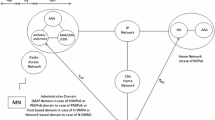Abstract
Wireless access to Internet services will become typical, rather than the exception as it is today. Such a vision presents great demands on mobile networks. Mobile IP represents a simple and scalable global mobility solution but lacks the support for fast handoff control and paging found in cellular telephony networks. In contrast, second- and third-generation cellular systems offer seamless mobility support but are built on complex and costly connection-oriented networking infrastructure that lacks the inherent flexibility, robustness, and scalability found in IP networks. This paper presents an overview and performance comparison of two of the main micro-mobility protocols, namely Cellular IP and Hierarchical Mobile IP with regards to the handoff process for UDP applications. The differences in the handoff quality of the two protocols are small and can be traced to design choices within the typical model. There are however significant differences regarding the processing requirement, routing efficiency and parameters relating to implementation and deployment.
Similar content being viewed by others
References
Z.D. Shelby, D. Gatzounas, A.T. Campbell and C.Y. Wan, Cellular IPv6, Internet draft, draft-shelby-seamoby-cellularipv6-00.txt, IETF Mobile IP Working Group Document, Nov. 2000.
E. Gustafsson, A. Jonsson and C.E. Perkins, Mobile IP Regional Registration, Internet draft-ietf-mobileip-reg-tunnel-04.txt, IETF Mobile IP Working Group Document, March 2001.
A.T. Campbell and J. Gomez, IP Micro mobility protocols, ACM SIGMOBILE Mobile Computer and Communication Review (MC2R), 2001 (to be published).
D.B. Johnson and C. Perkins, Mobility Support in IPv6, Mobile IP Internet draft, July 2000.
C. Perkins, editor, IP Mobility Support, Internet RFC 2002, Work in Progress, Oct. 1996.
CIMS: The Columbia IP micro mobility Suite NS Source Code Distribution for Cellular IP, Hawaii and Hierarchical Mobile IP, April 2001.
V. Tsaoussidis and I. Matta, Open Issues on TCP for Mobile Computing, Computer Science Northeastern University, Computer Science, Boston University.
L.S. Brakmo, S.W.O’Malley and L.L. Peterson, TCP Vegas: New Techniques for Congestion Detection and Avoidance, 1994 SIGCOMM Conference.
A.T. Campbell, J. Gomez, S. Kim and C.Y. Wan, Comparison of IP micromobility protocols 2002, IEEE Wireless Communications.
M. Ghassemian, Evaluation of different Handoff schemes for Cellular IP, A Dissertation submitted to King’s College, London for the Master of Science by Research 2001.
J.G. Castellanos, S. Kim, Z. Turanyi, A. Valko, C.Y. Wan and A.T. Campbell, Comet group, Columbia University, New York, Traffic lab, Ericsson research, A Comparison of IP Micro-Mobility Protocols.
A.T. Campbell, J. Gomez, S. Kim, A.G. Valko and C.Y. Wan, Columbia University, New York, Zo0ltan R. Turanyi, Technical University of Budapest, Design, Implementation, and Evaluation of Cellular IP.
H. Soliman, Ericsson, C. Castellucciah, Inria, K. El.-Malki, Ericsson and Ludovic Bellier, Inria, Hierarchical MIPv6 mobility management, July 2001.
A.G. Valko, Ericsson Research, Cellular IP: A New Approach to Internet Host Mobility.
Author information
Authors and Affiliations
Corresponding author
Rights and permissions
About this article
Cite this article
Frikha, M., Maalej, L. Micro mobility in the IP networks. Telecommun Syst 31, 337–352 (2006). https://doi.org/10.1007/s11235-006-6722-4
Published:
Issue Date:
DOI: https://doi.org/10.1007/s11235-006-6722-4




